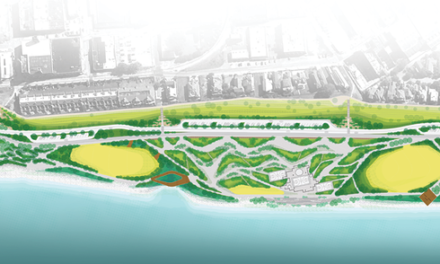From Sustainable Cities Collective:
“Parks are a part of our healthcare system,” said Dr. Daphne Miller, a professor of family and community medicine, University of California, San Francisco, at the Greater & Greener: Reimagining Parks for 21st Century Cities, a conference in New York City. She said these green spaces are crucial to solving hypertension, anxiety, depression, diabetes — “the diseases of indoor living.” The more someone spends outdoors, the less likely they are to suffer from mental or physical disorders. But she said parks officials and the medical profession still needs more data to take aim at the many “naysayers on the other side” who don’t believe in what every landscape architect values.
Lucky for all of us, a few scientists are doing innovative research, trying to capture that data. In a separate panel on healthcare and parks, Dr. Deborah Cohen, senior natural scientist at RAND, and Sarah Messiah, a research professor at the University of Miami presented some exciting results.
In a National Institute of Health (NIH)-financed study, Cohen has used “systematic observations” measuring “play in communities” to determine if and how people burn calories in parks (see downloadable app). Every hour 3 or 4 days a week, her team of researchers visited and counted people in target areas. Cohen was particularly interested in “vigorous” physical activity — the healthy kind of activity needed to get hearts pumping. Vigorous activity is defined as brisk walking, jogging, or running.
She said some 50 percent of all vigorous activity occurs in parks. Unfortunately, that doesn’t mean all that much for most because “hardly anyone engages in vigorous activity anymore.” For boys, the average is 2 minutes a day, and girls — just 1 minute a day. She found that while parks are the sites of that rare vigorous activity, they are still “underutilized.”
To measure the impact of new parks on the activity levels of people using these facilities, Cohen did a before and after study. She examined the activity levels of residents before three pocket parks came into low-income, high-crime areas in Los Angeles and then after. These are tiny parks (less than half an acre), mainly playgrounds, which aren’t staffed. She found that for two of the new parks, “the parks were better used than the larger parks serving larger areas.” People were “more likely to walk to the smaller neighborhood parks, which were perceived to be safer than the larger neighborhood park.” Walking gets the heart pumping.
Then, Cohen evaluated 12 “fitness zones,” otherwise just known as outdoor exercise equipment areas, installed by the Trust for Public Land (TPL), in Los Angeles. She found that these 12 fitness zones served a possible half a million people. Of the 23,500 people who used the parks, some 2,500 were in the fitness zones. Cohen found 2-4 people using them each hour on average. She said these fitness zones led to “increases in moderate, vigorous activity.” In comparison with neighborhood parks, there was a boost “but not a statistically-significant one.” Fitness zone use increased where they were accessible in higher density areas. Overall, she concluded these systems were “relatively cost-effective.” At $45,000 a piece, with a 15-year lifespan, these systems offer 11 cents per metabolic equivalent of task (MET), referring to the metric for measuring the energy use of physical activities. She said “anything under 50 cents per MET is worth it.”
Next, Cohen looked at the MET value of new facilities costing upwards of $1 million. In one L.A. park, she found that after the major improvements, the actual use of the park fell from 2,000 to 1,500 a day. She said this shows how important park programs are and how parks aren’t effective as calorie burners without them. The loss of people was due to “reduced hours, cut programs, less maintenance, and a shorter baseball season.” In the park, “less was happening so people went less.” She also added that the data told her “improved safety” isn’t a guarantee of improved use.
Looking at 50 parks in a randomized survey, Cohen went on to examine the impact of outreach or programs. One “control group” of parks didn’t receive any money. Another set was given $4,000 to do signage, courses, activities, really anything they want. The “control parks saw user levels fall, while the intervention parks saw increased users.” Each intervention saw an increase of about 174 more users per week, expending 521 more METs. Her conclusion: “There’s lots of competition for leisure time. Parks need to compete. That attention requires a modest investment” (but perhaps not a million dollar one).
Sarah Messiah with the Miller School of Medicine at the University of Miami and the Miami-Dade parks and pediatrics department is focusing her research on parks and childhood obesity. She said First Lady Michelle Obama was right: there is a national crisis with childhood obesity, with some 30 percent of American children now obese. She’s now seeing lots of kids with scary adult diseases like fatty liver disease and metabolic syndrome. “This generation could be the first that has a shorter lifespan than their parents.”
Miami-Dade has the third largest park system in the U.S.,with some 260+ parks over nearly 13,000 acres used by 2.5 million and visited by 10 million annually. With the park system as a platform, Messiah and her team wanted to test the effectiveness of after school programs in reaching a set of goals. Applying Fit2Play, a national ”interactive, fun wellness program” locally, the parks officials and researchers wanted to measure success on: (1) increasing physical activity, (2) eating right (nutrition), (3) improving school performance, and (4) building social skills and self esteem. The team also used SPARK after school programs, which offer a 400-page binder of activities, to train staff on activities to do in parks.
After school, kids from “dangerous” low-income neighborhoods were bused in. They spent an hour doing homework and then an hour of SPARK programs in the park for a year. Health and fitness coordinators and interns worked with park staff to obtain certification in fitness and wellness. Looking at Fit2Play outcomes, the researchers then collected a range of data on the 5-13 year olds, entering the actual data at parks. BMI, blood pressure, physical fitness, nutrition knowledge was all collected. The mean age for the study group was 9.3 years old, and there were half boys and girls.
The researchers found that the after-school programs were extremely beneficial. “The kids were growing normally,” said Messiah, instead of ballooning up abnormally. “There were statistically significant decreases in blood pressure,” which is “just important as weight.” Test performance “significantly improved over the year.” Nutrition knowledge improved, too.
Messiah said the key to the program’s success was the partnership between the parks system and university. “This was a team approach with lots of fluid communication both ways.” She realized that parks officials were really busy so the researchers had to “compromise on the time dedicated to measurement and data collection.” These people “can’t be expected to collect data all the time.” She also said it was also important to get parents to buy in and “sign those participation forms.”
Messiah and Cohen’s programs show that parks not only provide a safe place for people (and especially kids) in dangerous neighborhoods but are possibly key to their health and wellbeing. However, park space alone isn’t enough. The park programs are equally as critical. Without these opportunities, Messiah said, kids in these dangerous neighborhoods just sit inside, playing video games, eating junk food, growing into sedentary unhealthy adults disconnected from nature. While the investments needed clearly don’t need to be huge, parks still ”must be competitive in making their pitches in this tough financing environment.”




